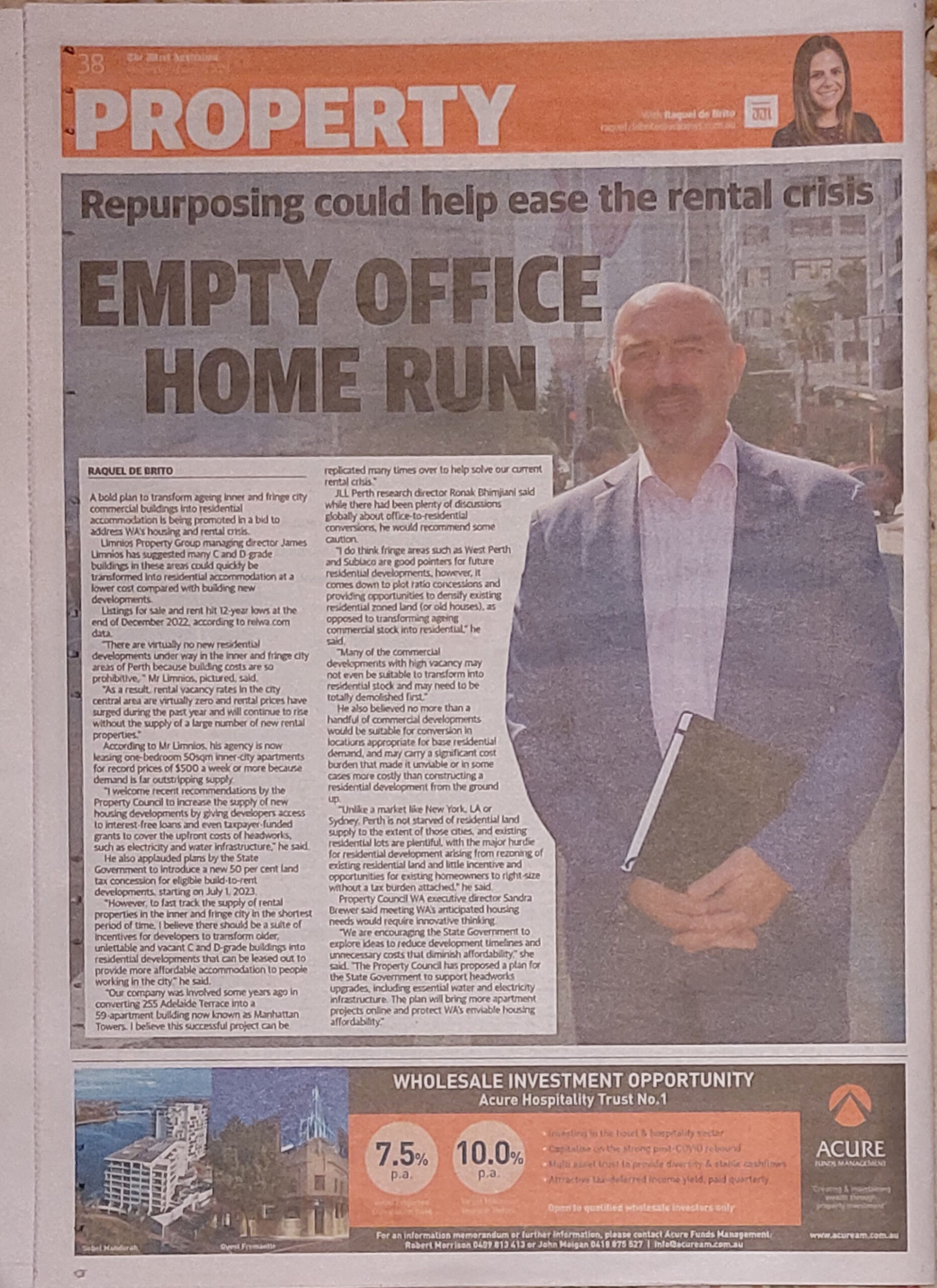A bold plan to transform ageing Inner and fringe city commercial buildings into residential accommodation is being promoted in a bid to address WA’s housing and rental crisis.
Limnios Property Group managing director James Limnios has suggested many C and D grade buildings in these areas could quickly be transformed Into residential accommodation at a lower cost compared with building new developments
Listings for sale and rent hit 12-year lows at the end of December 2022, according to reiwa.com data.
There are virtually no new residential developments under way in the inner and fringe city areas of Perth because building costs are so prohibitive,” Mr Limnios, pictured, said.
“As a result, rental vacancy rates in the city central area are virtually zero and rental prices have surged during the past year and will continue to rise without the supply of a large number of new rental properties.
According to Mr Limnios, his agency is now leasing one-bedroom 50sqm inner-city apartments for record prices of $500 a week or more because demand is far outstripping supply.
“I welcome recent recommendations by the Property Council to increase the supply of new housing developments by giving developers access to interest-free loans and even taxpayer-funded grants to cover the upfront costs of headworks, such as electricity and water infrastructure,” he said. He also applauded plans by the State Government to introduce a new 50 per cent land tax concession for eligible build-to-rent developments, starting on July 1, 2023.
“However, to fast track the supply of rental properties in the inner and fringe city in the shortest period of time. I believe there should be a suite of Incentives for developers to transform older, unlettable and vacant C and D-grade buildings into residential developments that can be leased out to provide more affordable accommodation to people working in the city,” he said.
“Our company was involved some years ago in converting 255 Adelaide Terrace into a 59 apartment building now known as Manhattan Towers. I believe this successful project can be replicated many times over to help solve our current rental crisis.
JLL Perth research director Ronak Bhimjiani said while there had been plenty of discussions globally about office-to-residential conversions, he would recommend some caution.
1 do think fringe areas such as West Perth and Subiaco are good pointers for future residential developments, however, it comes down to plot ratio concessions and providing opportunities to densify existing residential zoned land (or old houses), as opposed to transforming ageing commercial stock into residential,” he said.
Many of the commercial developments with high vacancy may not even be suitable to transform into residential stock and may need to be totally demolished first
He also believed no more than a handful of commercial developments would be suitable for conversion in locations appropriate for base residential demand, and may carry a significant cost burden that made it unviable or in some cases more costly than constructing a residential development from the ground up.
“Unlike a market like New York, LA or Sydney, Perth is not starved of residential land supply to the extent of those cities, and existing residential lots are plentiful, with the major hurdie for residential development arising from rezoning of existing residential land and little incentive and opportunities for existing homeowners to right-size without a tax burden attached,” he said.
Property Council WA executive director Sandra Brewer said meeting WA’s anticipated housing needs would require innovative thinking.
“We are encouraging the State Government to explore ideas to reduce development timelines and unnecessary costs that diminish affordability,” she said. The Property Council has proposed a plan for the State Government to support headworks upgrades, including essential water and electricity infrastructure. The plan will bring more apartment projects online and protect WA’s enviable housing affordability.”
Article by Raquel De Brito of the West Australian published on 18 January 2023.



